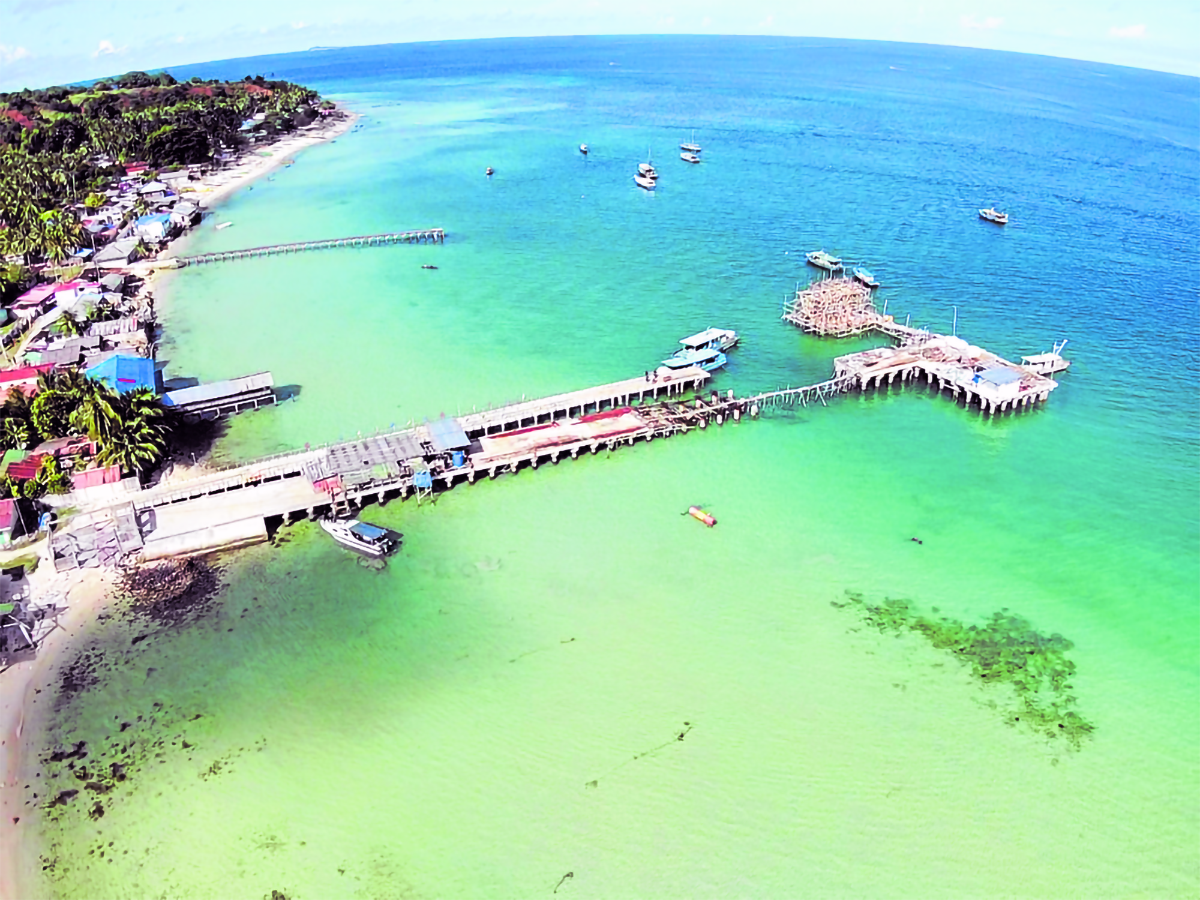Electricity brings new life to PH’s southern tip off Tawi-Tawi mainland

MAJOR LINK The port on Taganak Island in Tawi-Tawi province is the lifeblood of trade and commerce in the southernmost tip of the Philippines, near the border with Malaysia. —PHOTO COURTESY OF BANGSAMORO PORT MANAGEMENT AUTHORITY
TAGANAK ISLAND, TAWI-TAWI — To the mostly fisherfolk families on this island in the Philippines’ southern tip, the black power cables connecting an electricity post to their households are a very welcome sight.
“It means hope; it means better life,” says Nur Aina Shariff Banding, 58, who supports her children by selling drinks and food coming from Sandakan, Malaysia.
The thought of electricity now reaching their homes on Taganak Island excites Shariff who equates such development to having a better economic opportunity. “We will no longer need to buy ice from Sandakan; we can already make our own that we can sell,” she said in Filipino.
Apart from offering cool refreshments, ice is used to preserve the freshness of the community’s fish catch.
READ: Tawi-Tawi, a tourism diamond in the rough
Article continues after this advertisementLocal business owners prefer to trade in Sandakan which is only a 30-minute boat ride away unlike the nearest point inside the Philippines, Tawi-Tawi’s capital town of Bongao, which is 18 hours away by boat.
Article continues after this advertisementSpanning over 100 hectares, Taganak has good roads, a port serving some five dozen wooden-hulled boats, and mobile phone and internet connectivity. But its isolation is the biggest hurdle in improving the lives of its people. Official estimates classify a third of this fifth-class municipality’s 5,683 residents as poor.
Taganak is the largest of seven islands in what is known as Tawi-Tawi’s Turtle Islands, which lie on the edge of the country’s border with Malaysia. Together with the Mangsee Islands of Palawan, sovereign control over Taganak was handed to the country by the British government in 1947.
The pioneering islanders live off trading copra and marine turtle eggs, which commands a high price as it is among Southeast Asia’s traditional exotic delicacies.
A study commissioned by the Department of Environment and Natural Resources in 2020 showed that conservation efforts in the 1980s and 1990s led to a marked decline in the harvesting of marine turtles and their eggs, although it noted that there had been a recent rise in these activities due to economic pressures.
Taganak is within the Turtle Islands Heritage Protected Area (Tihpa), regarded as the largest marine turtle nesting ground in Southeast Asia by the World Heritage Centre of the United Nations Education, Scientific and Cultural Organization.
P46-M investment
Declared in 1996 through a cooperation agreement between Malaysia and the Philippines, Tihpa is the first transboundary protected area. It comprises nine islands—three on the Malaysian side and six on the Philippine side, all protected under the respective countries’ laws.
Mayor Mohammad Faizal Jamalul said that over 2,000 households in his island town are looking forward to seeing their homes lit by electricity produced by the National Power Corp. (Napocor), which has invested P46 million to put up three diesel-fired power generating units, each with a 50-kilowatt capacity.
The electricity lines were established by the Ministry of Environment, Natural Resources and Energy of the Bangsamoro government, while the entire retail power distribution is managed by Cagayan de Sulu Electric Cooperative (Caselco). Electricity supply began reaching Taganak homes on Tuesday.
READ: Trade ties between Tawi-Tawi and Labuan, Malaysia rekindled
Engineer Yahcob Darayan, Napocor’s department manager for Mindanao operation, said the current generating capacity could initially light up 1,050 houses, with families able to use electric fans, flat irons, rice cookers and light bulbs, and charge phones and electronic gadgets.
Darayan said energization plans for Taganak were discussed starting in 1986 but these were not immediately carried out due to various reasons, among them the likely impact of the availability of electricity on the long-term viability of the island as part of a protected marine area.
Reality
According to Darayan, they can further increase the power generating capacity once the distribution system stabilizes. “Throughout my 49 years in Taganak, this dream (of having electricity) has become a reality. Just imagine the people who were ahead of us, who struggled throughout their lives without electricity,” Jamalul told the Inquirer.
Prior to Napocor’s power plant, homes and businesses use generator sets to produce electricity, which is costly and noisy.
Businessman Gorgon Alegre, who runs a convenience store, said the electricity distributed by Caselco brings down their power costs, noting that gensets could not support the production of ice at the volume required by local fishermen.
“I know how hard it is living on the islands and in areas without electricity. Now, I am happy to see that the last frontier in the Philippines is now energized,” said Alegre, a native of Sulu.
Jamalul noted that Taganak’s people hardly go to Bongao or Sulu to buy basic necessities and other goods.
“We go to Sandakan to buy vegetables, oil, dry goods, fuel, canned goods, anything, including our prized commodity, ice,” the mayor said. “With a power plant here now, the first project we are putting up is an ice plant, so we no longer travel to Malaysia to secure ice.”